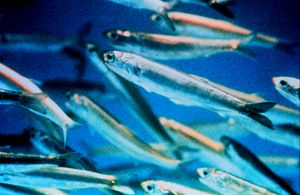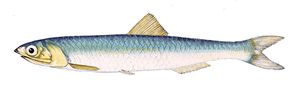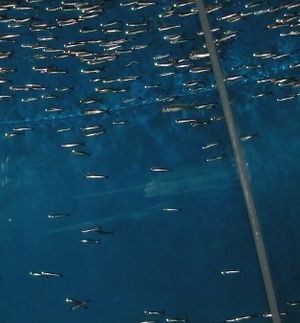أنشوجة
| Anchovies | |
|---|---|

| |
| التصنيف العلمي | |
| مملكة: | |
| Phylum: | |
| Class: | |
| Order: | |
| Family: | Engraulidae
|
| Genera | |
|
Amazonsprattus | |
الأنشــوجة Anchovy سمك يستخدم طعامًا وهو شبيه بسمك الرنجة. تُستخدم أسماك الأنشوفة في السَّلطة والبيتزا والحساء وغالبًا ما يتم تعليبها وتجفيفها وتصنيعها في نوع من العجينة. ويأكل بعض الناس هذه الأسماك وهي مطبوخة طازجة.
تحتوي هذه الأسماك على لحم زيتي وطريِّ. ويبلغ طول معظم هذه الأسماك أقل من 10سم، ويوجد لهذه الأسماك عيون كبيرة وأنف طويل بارز بشكل واضح إلى ما بعد فكها السفلي. ولون سمك الأنشوفة فضي من الناحية السُفلى وأخضر أو أزرق من ناحية الظهر.
يسبح سمك الأنشوفة في جماعات كبيرة، وتعيش معظم هذه الأسماك في مياه ساحلية ضحلة، في المناطق المدارية الدافئة. ويتم صيد أعداد هائلة من هذا السمك في البحر الأبيض المتوسط وعلى طول ساحل بيرو في أمريكا الجنوبية. ويُدعى السمك الذي يتم صيده على ساحل بيرو من هذا النوع من الأنشوفة باسم الأنسوفيتا.
الاستهلاك
في ماليزيا والأسيان تعتبر الأنشوفي كالملح في كل مكان, وتحفظ مجففة ومقلية, وتستخدم الأنشوفي في أشهر الأطباق الأسيوية مثل "ناسي ليماك".
أما في بلاد المتوسط فغالبا تملح وتحفظ في الزيت, وهي مشهورة بعدة أكلات في مصر واليونان وإيطاليا وأسبانيا.
الأجناس
| Genera in the family Engraulidae | ||||||
|---|---|---|---|---|---|---|
| Genera | Species | Comment | Genera | Species | Comment | |
| Amazonsprattus | 1 | Anchoa | 35 | |||
| Anchovia | 3 | Anchoviella | 4 | |||
| Cetengraulis | 2 | Coilia | 13 | |||
| Encrasicholina | 5 | Engraulis | 9 | Type genus for anchovy: This genus contains all the commercially significant anchovy. | ||
| Jurengraulis | 1 | Lycengraulis | 4 | |||
| Lycothrissa | 1 | Papuengraulis | 1 | |||
| Pseudosetipinna | 1 | Pterengraulis | 1 | |||
| Setipinna | 8 | Stolephorus | 20 | |||
| Thryssa | 24 | |||||
الخصائص

Anchovies are small, green fish with blue reflections due to a silver-colored longitudinal stripe that runs from the base of the caudal (tail) fin. They range from 2 to 40 cm (0.79 to 15.75 in) in adult length,[1] and their body shapes are variable with more slender fish in northern populations.
The snout is blunt with tiny, sharp teeth in both jaws. The snout contains a unique rostral organ, believed to be sensory in nature, although its exact function is unknown.[2] The mouth is larger than that of herrings and silversides, two fish which anchovies closely resemble in other respects. The anchovy eats plankton and recently hatched fish.
التوزيع
Anchovies are found in scattered areas throughout the world's oceans, but are concentrated in temperate waters, and are rare or absent in very cold or very warm seas. They are generally very accepting of a wide range of temperatures and salinity. Large schools can be found in shallow, brackish areas with muddy bottoms, as in estuaries and bays. The European anchovy is abundant in the Mediterranean, particularly in the Alboran Sea,[3] Aegean Sea and the Black Sea.
This species is regularly caught along the coasts of Crete, Greece, Sicily, Italy, France, Turkey, Northern Iran, Portugal and Spain. They are also found on the coast of northern Africa. The range of the species also extends along the Atlantic coast of Europe to the south of Norway. Spawning occurs between October and March, but not in water colder than 12 °C (54 °F). The anchovy appears to spawn at least 100 km (62 mi) from the shore, near the surface of the water.
البيئة
The anchovy is a significant food source for almost every predatory fish in its environment, including the California halibut, rock fish, yellowtail, shark, chinook, and coho salmon. It is also extremely important to marine mammals and birds; for example, breeding success of California brown pelicans[4] and elegant terns is strongly connected to anchovy abundance.
سلوك التغذي
Anchovies, like most clupeoids (herrings, sardines and anchovies), are filter-feeders that open their mouths as they swim. As water passes through the mouth and out the gills, food particles are sieved by gill rakers and transferred into the esophagus.[5]
الأنواع التجارية
| هذا المقال هو جزء من سلسلة عن |
| الأسماك التجارية |
|---|
| الكبيرة بأعالي البحار |
| الفريسة |
| Demersal |
| مختلط |
| أخفCommercially significant species | ||||||||||
|---|---|---|---|---|---|---|---|---|---|---|
| Common name | Scientific name | Maximum length |
Common length |
Maximum weight |
Maximum age |
Trophic level |
Fish Base |
FAO | ITIS | IUCN status |
| European anchovy* | Engraulis encrasicolus (Linnaeus, 1758) | 20.0 cm (7.9 in) | 13.5 cm (5.3 in) | kg | 5 years | 3.11 | [6] | [7] | [8] | Not assessed |
| Argentine anchoita | Engraulis anchoita (Hubbs & Marini, 1935) | 17.0 cm (6.7 in) | cm | 0.025 kg (0.88 oz) | years | 2.51 | [9] | [10] | [11] | Not assessed |
| Californian anchovy | Engraulis mordax (Girard, 1856) | 24.8 cm (9.8 in) | 15.0 cm (5.9 in) | 0.068 kg (2.4 oz) | years | 2.96 | [12] | [13] | [14] | |
| Japanese anchovy | Engraulis japonicus (Temminck & Schlegel, 1846) | 18.0 cm (7.1 in) | 14.0 cm (5.5 in) | 0.045 kg (1.6 oz) | 4 years | 2.60 | [16] | [17] | [18] | Not assessed |
| Peruvian anchoveta | Engraulis ringens (Jenyns, 1842) | 20.0 cm (7.9 in) | 14.0 cm (5.5 in) | kg | 3 years | 2.70 | [19] | [20] | [21] | |
| Southern African anchovy | Engraulis capensis (Gilchrist, 1913) | 17.0 cm (6.7 in) | cm | kg | years | 2.80 | [23] | [24] | [25] | Not assessed |
* Type species
مصايد الأسماك
الهامش
|
المصادر
- الموسوعة المعرفية الشاملة
- Froese, Rainer, and Daniel Pauly, eds. (2006). "Engraulidae" in FishBase. January 2006 version.
- PSMFC.org
- Francisco P, Chavez FP, Ryan J, Lluch-Cota SE and Ñiquen C M (2003) From Anchovies to Sardines and Back: Multidecadal Change in the Pacific Ocean Science 229(5604)217–221.
وصلات خارجية
- Fisheries Ebb and Flow in 50-Year Cycle National Geographic News (2003).









